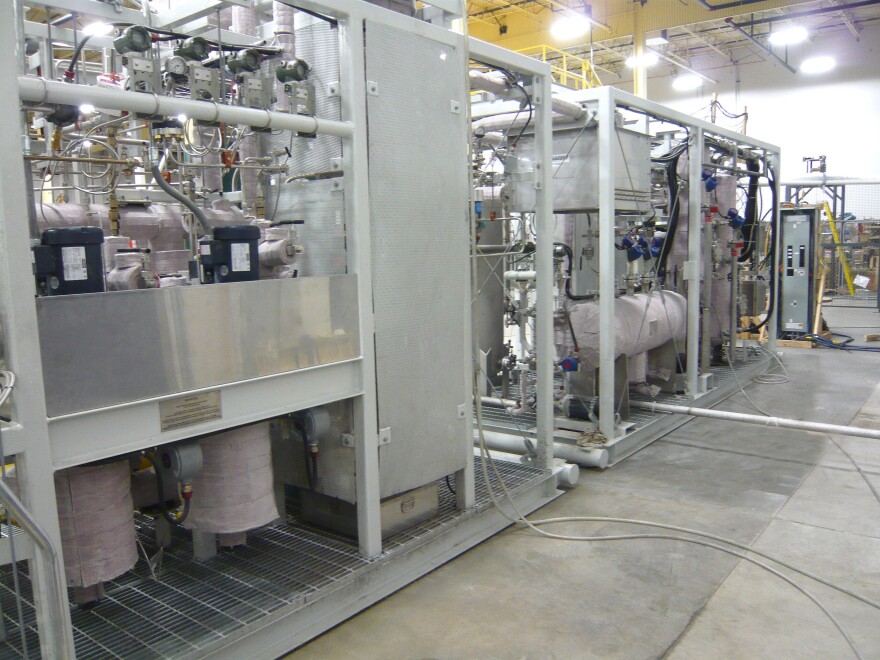What if there was a way to turn trash into treasure or even take something deemed unusable and give it new purpose? Well, sewage sludge—yes, a product of what goes down your toilet and drain—is getting a new start as fuel. Scientists at the Department of Energy’s Pacific Northwest National Laboratory and the Utah-based Genifuel Corporation have developed a simple, yet powerful approach for generating fuel from waste using a technology known as hydrothermal processing.
"What comes out of our process is very similar to crude oil. It can be used in the same ways." -James Oyler, President of Genifuel Corporation
“Hydrothermal, as you can tell from the word, is a wet and hot pressurized process. It accomplishes the conversion of organic materials into biocrude oil and natural gas,” said James Oyler, president of Genifuel Corporation. “This is exactly the process by which fossil fuels are made.”
Over millions of years, Mother Nature converts wet organic matter in the form of dead animals and plants into fossil fuels. As the dead material is buried, its exposure to high pressure and temperature gives rise to chemical conversions that results in crude oil, natural gas, and coal. Scientists have pretty much replicated this process, but with some added benefits—they are making fuel from renewable materials like sewage sludge, manure, and agricultural waste and can do so in significantly less time.
“In our case, we select the temperature and pressure to make biocrude oil and methane (natural gas). The only difference is we do it in about 45 minutes rather than millions of years,” said Oyler. “What comes out of our process actually is very similar to crude oil. It can be used in the same ways. We can take our biocrude produced through hydrothermal processing, send it to a refinery, and mix it right in with petroleum to make finished fuels like gasoline, kerosene or diesel fuel.”
Oyler noted that hydrothermal processing offers one advantage that may not be so obvious—the ability to use wet starting material. Many other biofuel technologies actually need dry feedstocks. This poses limitations, as water removal is energy intensive and expensive. Being able to use a wet sludge has now made sewage attractive, a word otherwise never attributed to human waste.

The waste-to-fuel transformation begins by preparing the feedstock, in this case, wastewater solids.
“Those solids are made into a slurry, a thick wet mix. It's almost like making a Slurpee in a food processor,” Oyler said. “The slurry is pumped up to a pressure of 3,000 pounds per square inch and then heated to about 660 degrees Fahrenheit.”
The pressure is about one hundred times greater than a car tire. And while 660 degrees Fahrenheit is certainly hot, it is actually quite moderate in comparison to other industrial processes, which typically run at least double that temperature.
Ultimately, hydrothermal processing is multi-step process that disposes of waste by converting it into biocrude oil, methane, and clean water. In fact, nearly 100% of the organic solids are converted into biocrude or natural gas. Other chemicals like phosphorus, used in fertilizer, are recovered as well.

“This is a very cost effective and efficient process. We only use about 14% of the energy we make to run the system,” said Oyler. “We’re not wasting a lot of energy, which means we are getting 86% of the energy back out as fuel. That’s a very high number.”
What does the future of fuel actually look like with hydrothermal processing added in the mix? The conversion of wastewater solids would account for about 2% of the total amount of transportation fuel in the United States, but Oyler said that if animal, agricultural, and wood waste is also processed that percentage could rise to as much as 25%.
A demonstration system to process sewage sludge for a population of 30,000 is currently underway in collaboration with Canada’s Metro Vancouver and one of its wastewater treatment plants. Upon successful testing, the goal is to bring hydrothermal processing technology to other facilities worldwide.
Additional information: A video provided by Pacific Northwest National Laboratory shows the process of going "from the toilet to the tank."
https://www.youtube.com/watch?v=ER4C6EapZQ4


